The good news is that even if you don’t train your young avocado tree to the perfect shape, the tree can still ultimately be healthy, balanced, and fruitful. I should know. I’ve got a number of mature avocado trees that perform well but that I wish I had trained somewhat differently in their early years.
So this post is about how I go about forming the shapes of my new trees these days — an improved approach, I think — in order to achieve four main goals: the tree is able to stand without the aid of stakes, it can carry a fruit load, it won’t interfere with irrigation, and it retains the leaf litter it drops and shades its trunk and rootzone.
You would be justified, however, in training your own tree in other ways or additional ways. “Any suggestions made must be interpreted in the light of their own individual conditions, and not taken as set rules to be applied anywhere, regardless of conditions,” wrote Carter Barrett back in 1935 in his article for the California Avocado Association, “Training and Pruning Avocado Trees.” I say the same about my suggestions today.
Standing without a stake
Getting a young avocado tree off the crutch of a stake within a year or two after planting primarily requires keeping its canopy balanced. If the tree grows a side branch that is fat at its base relative to the size of the leader/trunk (more than a third the size of the trunk can be considered fat), that branch should probably be checked or it will eventually make the canopy too large and heavy on its side, and the tree won’t be able to stand on its own without a stake.
In the past, I’ve left such vigorous side shoots unchecked on a young tree only to later have to cut them back drastically in order to get the tree to stand without stakes. I now prefer to consistently nip them back or remove them as soon as I spot them.
One young tree in my yard that has a vigorous side shoot is this Hass:
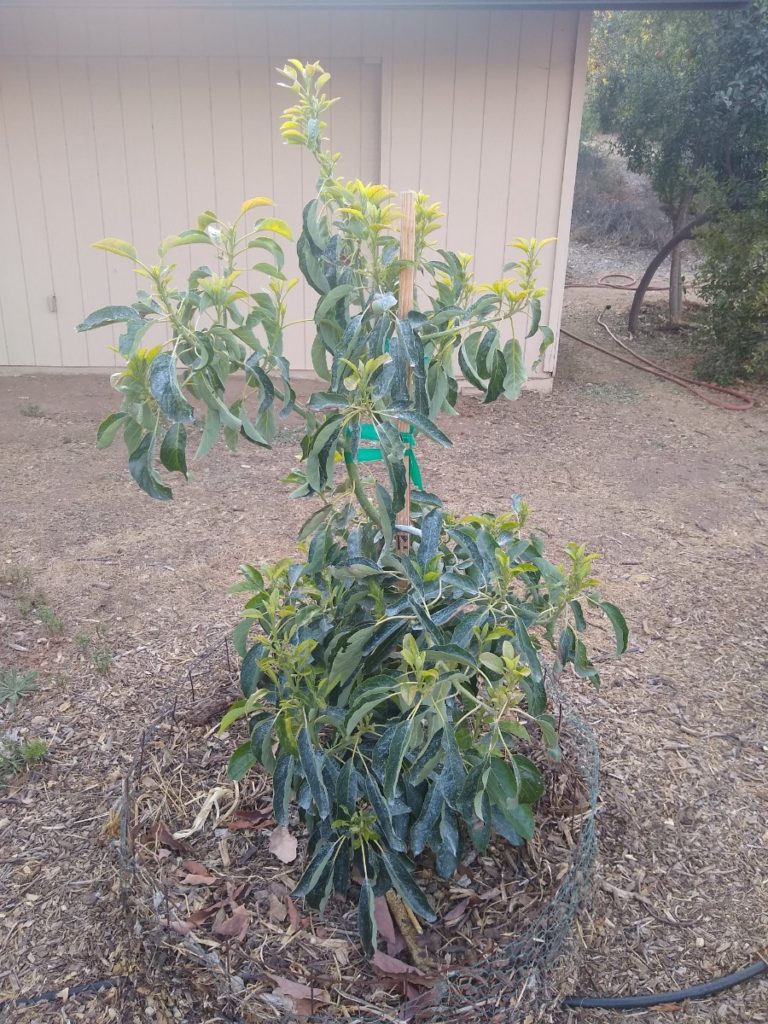
Another tree with a vigorous side shoot is this Ettinger:
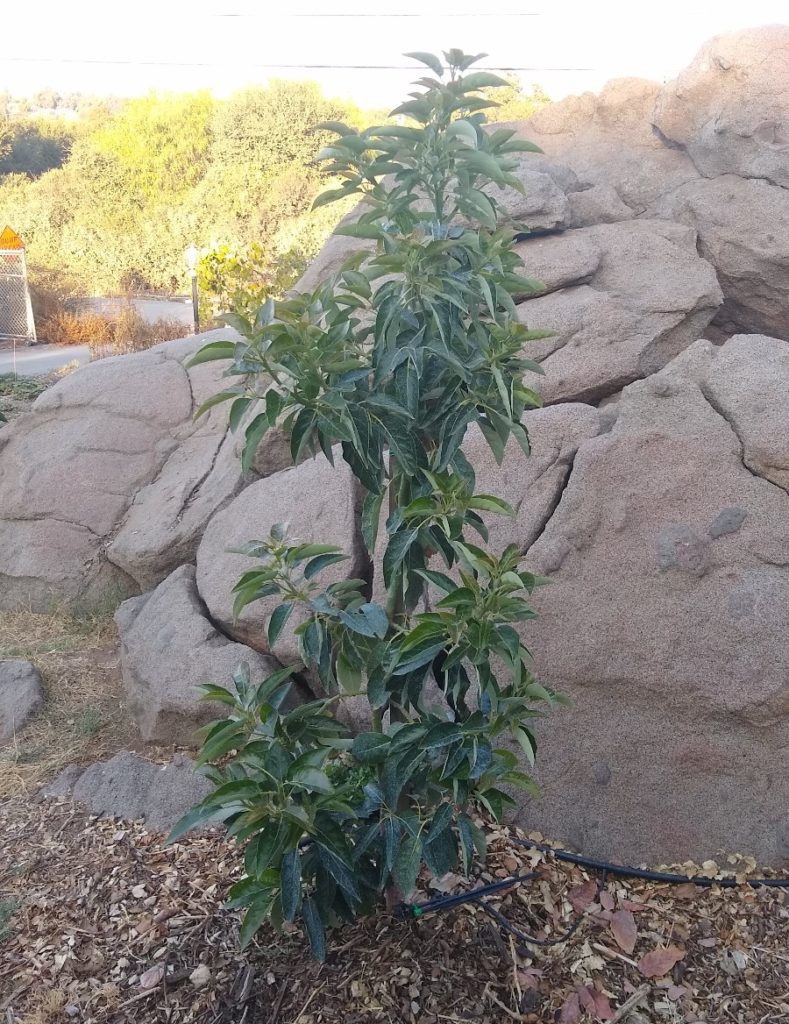
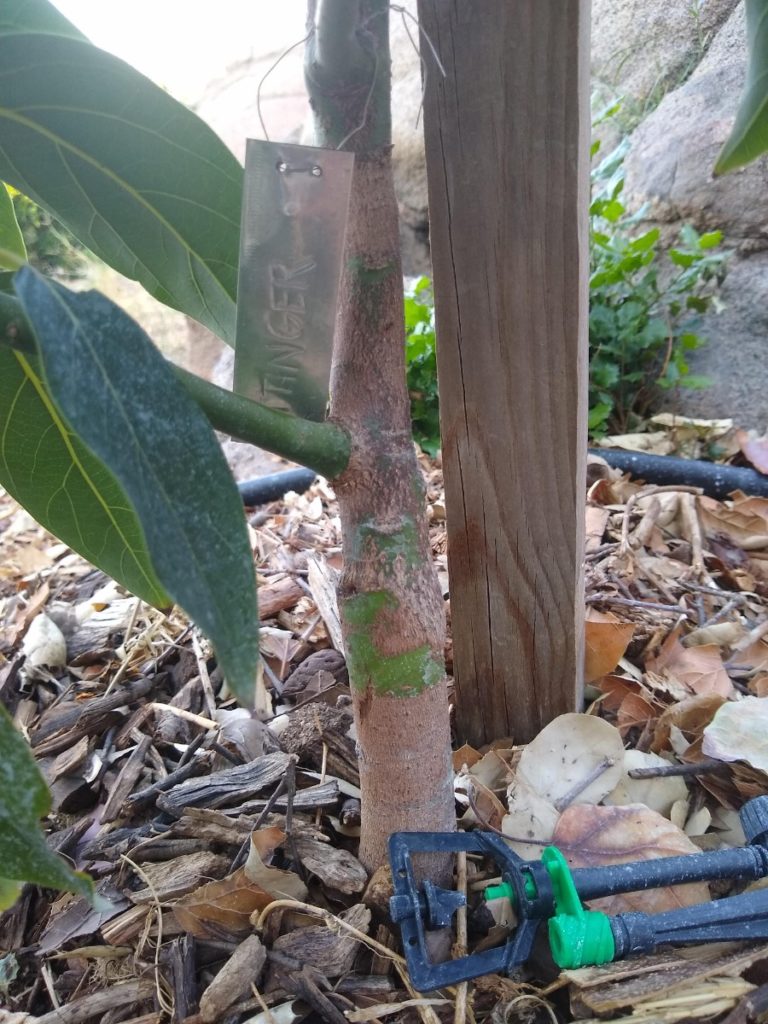
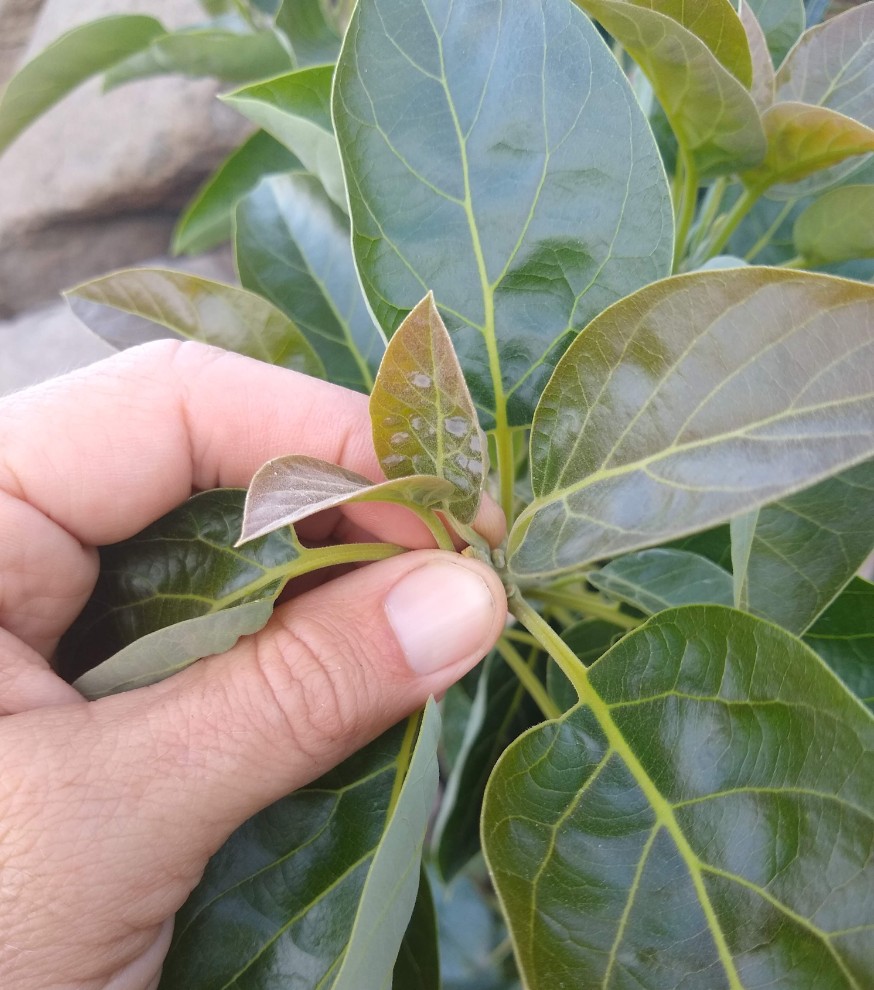

Allowing the tree to choose a new leader
There is an exception, however. If a vigorous side branch is aiming vertically, you might want to go with it and allow the branch to become the new leader/trunk of the tree. I’ve allowed this a number of times and it has worked out successfully in the long run. Sometimes it seems that the tree chooses this new branch as a leader and sends it an abundance of energy, and we would do well to listen to the tree rather than fight it, as insisting on the leader that we have chosen results in a slower growing tree overall. But it’s important that this new leader is naturally aiming close to vertical or else it can’t be managed.
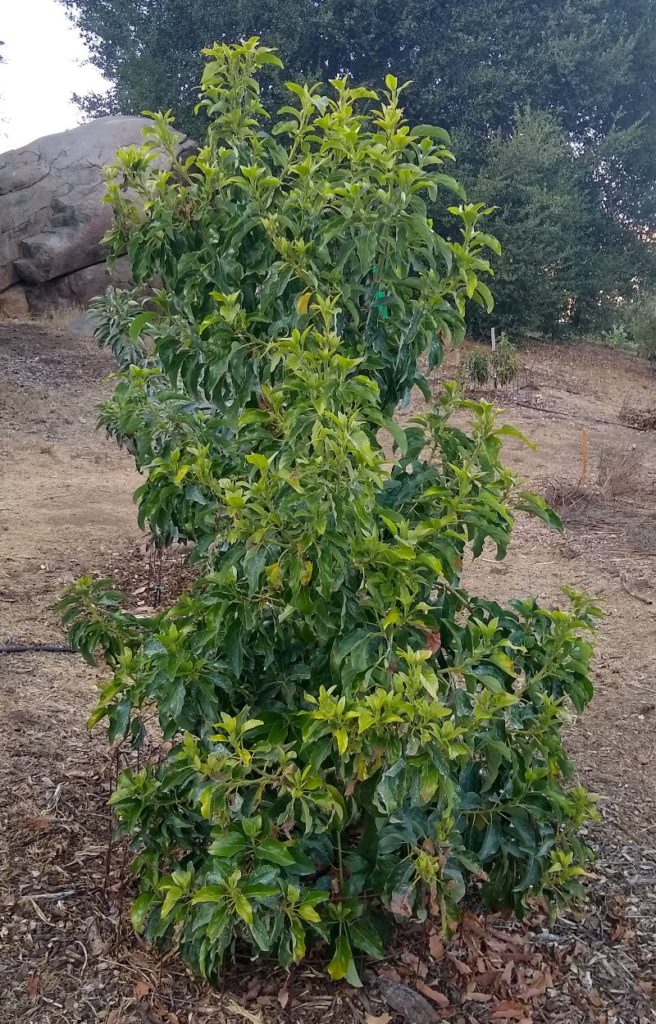
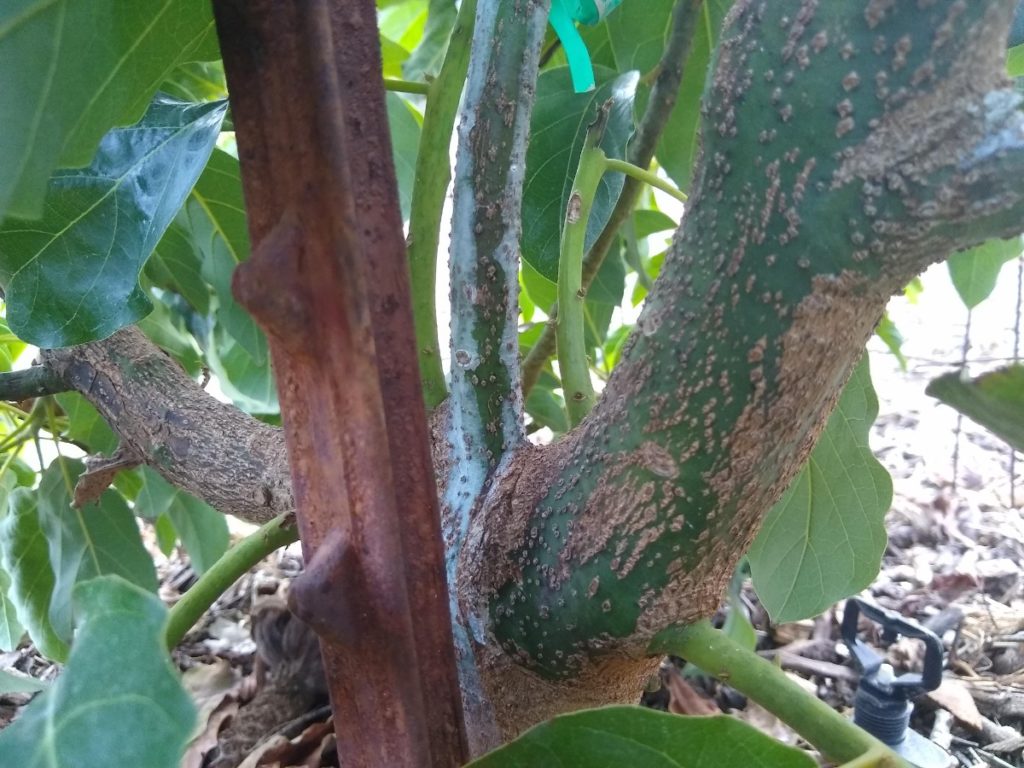
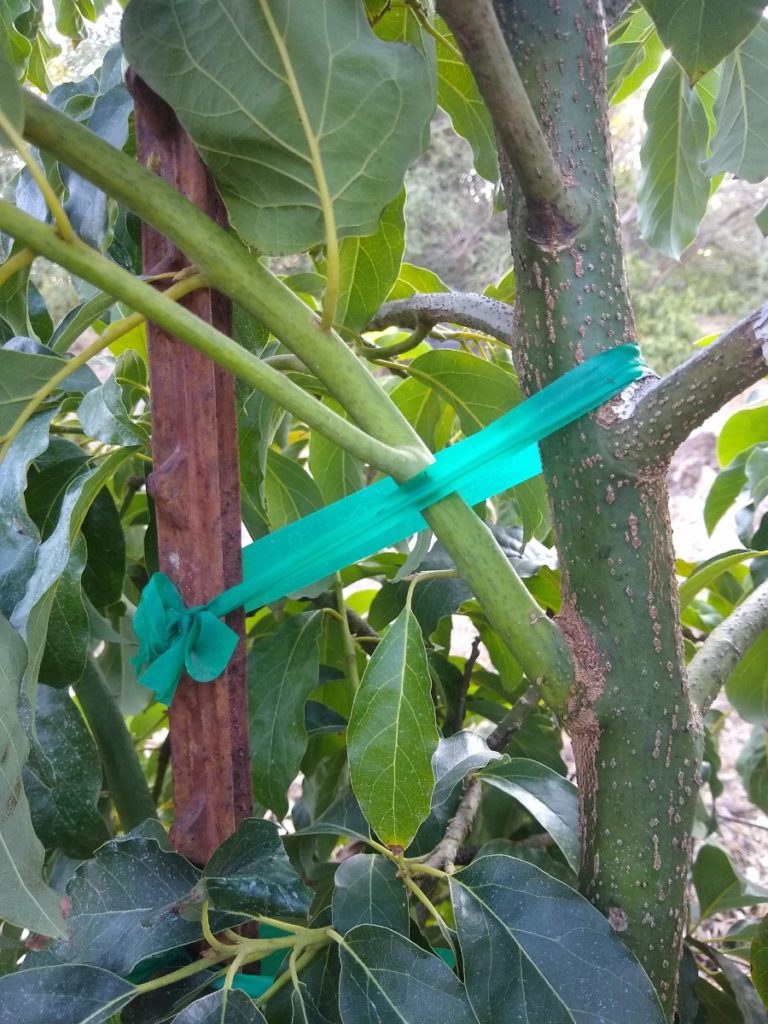
Carrying a fruit load
Having a balanced canopy prior to fruitset is vital for a young tree because of how heavy the avocados become. If a tree is lopsided when it starts developing fruit (in the spring), then the fruit usually exacerbates this and causes the tree to lean and can threaten to topple it, especially if it’s on a slope or if it must deal with strong winds.
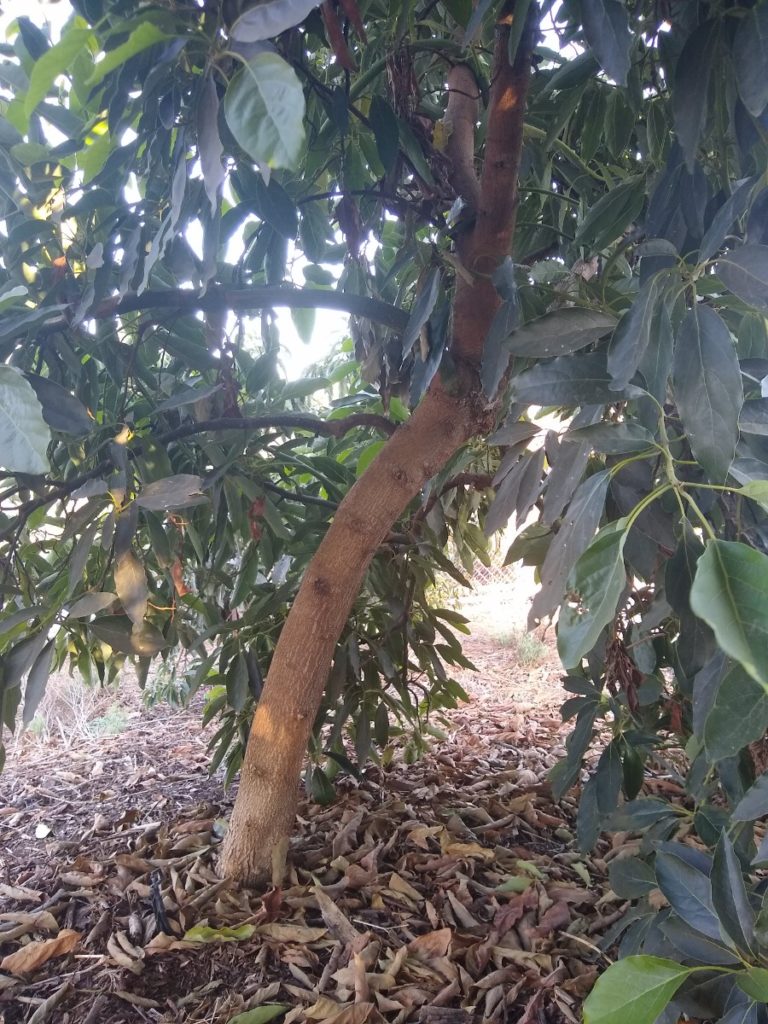
Also, do you care if the fruit develops while touching the ground? Such avocados become discolored on their bottom side, usually appearing light green or yellow where they touch the ground. It’s only a skin blemish so I personally don’t mind. But if you do, then you want to prevent this by incrementally removing low branches (branches below about knee height can be considered low). You might also need to shorten other low branches (that are still above knee height) because if they set fruit near their tips, that fruit can cause the branch to sag enough to land the fruit on the ground.
Retaining mulch and shading the trunk and rootzone
Yet my preference is not to just remove all low branches on an avocado tree at the time of planting because low branches are functional and useful, especially for the smallest trees. The more branches and leaves a tree has, the more energy it creates and the faster it can grow up to productive size. On a small avocado tree, say under eight feet tall or so, low branches perform this function about as well as high branches.
Also, low branches serve as protection and as a buffer. Especially helpful in windy areas, these low branches keep the leaf litter that begins to fall and collect under a tree from blowing away. And especially helpful in hot areas, low branches provide shade to the young tree’s trunk, which can easily sunburn. The roots also appreciate the shade, as they fry if the soil gets too hot. So my preference is to incrementally remove low branches as the tree grows taller.
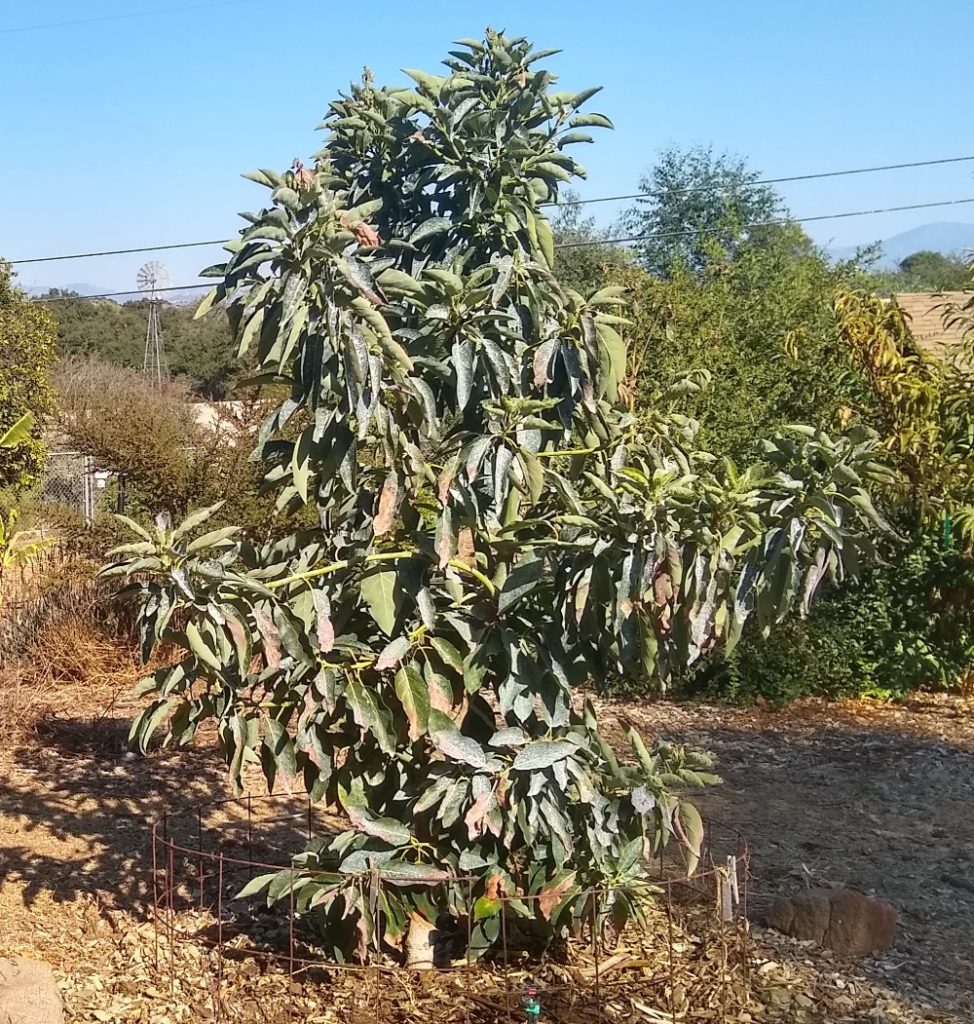
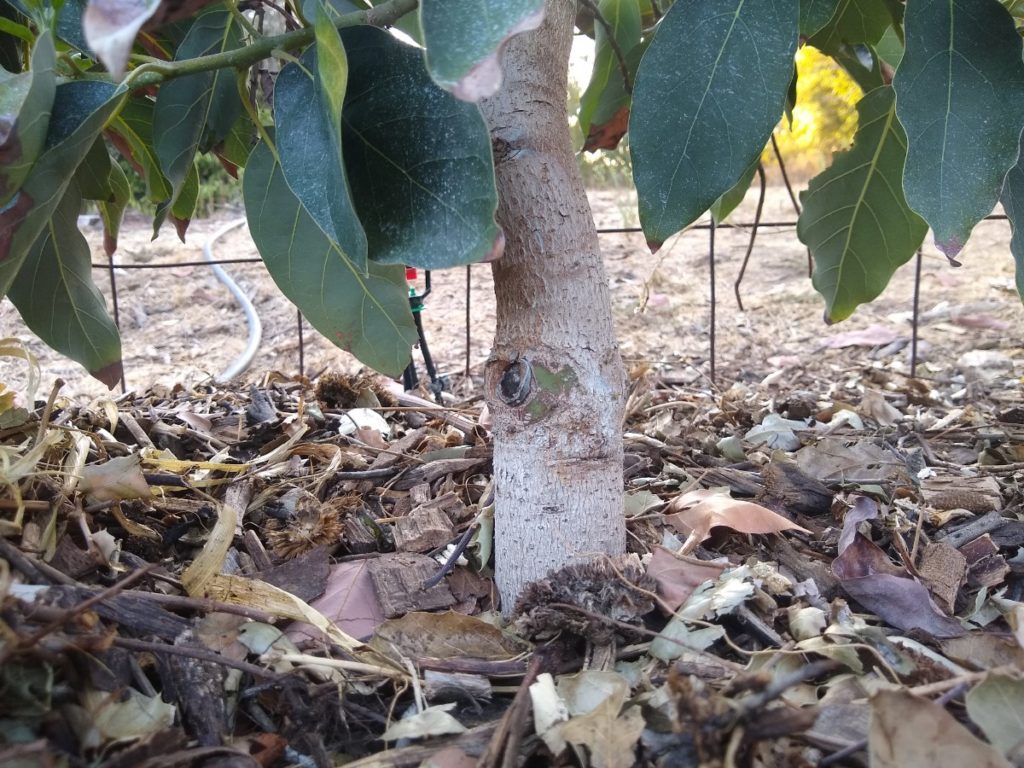
Not interfering with irrigation
A convenience of watering an avocado tree with drip irrigation is that low branches don’t interfere. But if you use any type of sprinkler or sprayer, then over time you’ll want to remove some lower branches so they don’t block the distribution of the water.
If irrigating with a sprinkler or sprayer, it’s also ideal to train the young tree to a single trunk up to about knee height. If you let the tree form large branches below that level, they will probably interfere with your irrigation water. I’ve made the mistake of letting avocado trees branch into multiple trunks down low and — while it makes for a great climbing tree for the kids — it prevents me from placing my sprinklers wherever I want around the tree.
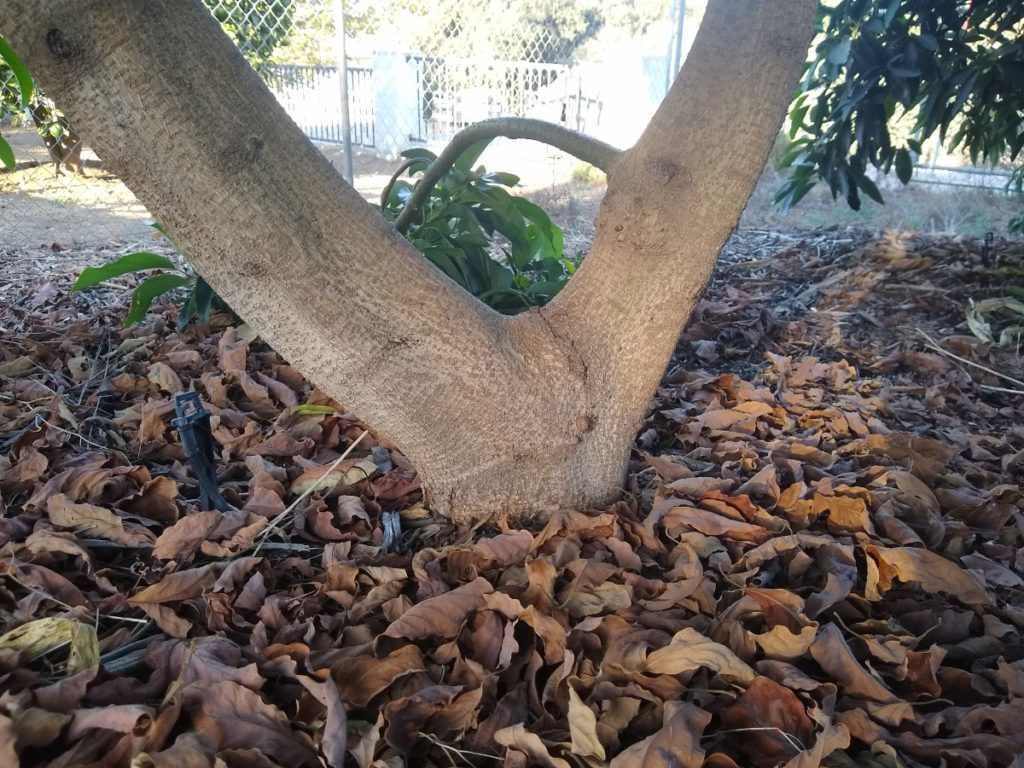
How and when to train
As a final note: I’ve found that by continually assessing the form a young avocado tree is taking, you can train it to a desirable shape by almost never needing to cut a branch. Just pinch the terminals of a vigorous side shoot. Or tie a new leader to the stake. Do it early in the life of the tree, and within a couple years the tree will likely be able to stand on its own, carry a crop of avocados, and face a strong Santa Ana — few, if any, tools having been required.
Video
Here I show some of the same avocado trees as above and talk about how I’ve trained them or wish I had trained them.
My post about pruning avocado trees in general is here.
You might also like to read my post about planting and staking an avocado tree.
All of my Yard Posts are listed HERE




Hi Greg,
Is October, or any other time of the year, particularly good or bad time to prune a tree to keep it balanced or too low and blocking irrigation? I’ve got a few branches that are too big to pinch off or too low, and will need to be pruned to maintain balance. When is best to do this?
Hi Dave,
In general, the best time to do that pruning is as soon as you see the need. Whatever problems the branches are causing (imbalance, blocking irrigation, etc.) will only get worse with time, as the branches continue to grow.
Have you ever notched an avocado tree? A guy did this above a node on a fig tree, and a new branch came out.
Hi Rob,
Yes, I have tried this and it works on avocados just as you described with the fig, except that on avocados there are many latent (invisible) buds so you can ring or girdle a limb and get many sprouts below that point.
Hi, have been researching ways to induce new shoots / branches for avocado trees and have found little. Would love some help. I’m a novice espalier fan and have started a fig (doing well and notching worked impeccably) and a Brogdon Avocado (notching did not work).
This tree will be kept fairly tight on a trellis — how the heck can I make it branch?!?
I’m not familiar with girdling.
Hi Kevin,
You can make avocados branch (fork) by pinching the tips of young shoots. And you can make a larger branch form sprouts at a particular location by girdling just above where you want the sprouts. (Usually, but not always, this induces sprouts.)
See more on girdling avocados here: https://gregalder.com/yardposts/girdling-avocado-trees-for-consistent-fruiting/
Great thanks! I’ve got two new babies, a Hass and a Reed. They just went in the ground in July so I’m not sure I should prune anything yet, but I will keep an eye on them for balance.
Thanks Greg, I’ve planted two trees very close together and need to train them carefully. They are 1 1/2 YO, I should have started earlier…I’ll also look at the 1935 article. Thanks again for your help.
I have planted many 5 gal avos, the system that works best for me over time is a large tomato cage.
When you say “train the tree” that is what you are doing, you are not growing fruit.
Usually fruit on a young tree drops as soon as you say “ummm that’s going to be good”
The tomato cage needs no stake and has many points to attach string or plastic tape.
Cheesecloth or screen can be easily attached for uv protection.
The tree is trained 100% Apical, all laterals beyond the cage are pinched or tipped (+ or – two or three inches. No laterals to exceed 1/3 of dia of trunk or touching the ground.
I have a Holiday avo tree 5 feet tall and it looks like a Christmas tree
Result: A tree that stands 4 to 5 feet, well shaped, and a trunk Dia that may hold a few fruit.
Prune any time you see something out of order, the longer you wait the worse it becomes (because if it sets fruit, you will never cut it off.)
Hi Dennis,
I’m really intrigued by this method. In a way, I’ve almost used it before as I do put tomato cages (large ones made of concrete reinforcement wire) around some of my young trees in order to perform other tasks. I wrap the bottom with poultry wire to keep rabbits from chewing the trunk and to keep my chickens from scratching away the mulch. I also put shade cloth over the top during heat waves, and I put a frost blanket or piece of plywood over the top during a freeze. But I’ve never thought of keeping the cage on to use as a training form. I’m going to have to try it out.
When do you remove the cage? Whenever you see that the tree is strong enough to not need it? Before it sets fruit? (I can’t imagine removing the cage without knocking off fruit.)
Hi Greg,
Yes the large tomato cages work great for a “just planted” 5 gal avo tree.
The rings on the cage let you tie a loop around the tree and tug straight in any direction.
When you remove the cage depends on growth rate for that first year or two.
If fruit sets on such a young tree, it is easily supported by the many rings on the cage.
I had a two foot tall reed with one avo, the sun burned it off. (the tree grew faster)
You can remove the cage after fruit harvest, or cut with wire cutters.
The idea is to get that tree trunk about 3/4 inch, apical, short laterals that can support fruit and then let the tree take on it’s natural shape.
This is the method I have used on unruly holidays, pinkertons and reeds that want to be bushes rather than trees..
The gems and lambs laterals seem less apt to dominate the tree.
Anyway, that’s how I do it in my corner of the world.
Great topics Greg,
I really enjoy photos of your slice of heaven there in Ramona.
Another timely post, as I would like advise on my tree. I loosely staked it for the first few months, but not at all the past couple. Here’s a picture, the tree was planted 6 months ago, 5 gallon pot:
https://photos.app.goo.gl/TH3APUJxojdcjPAe9
I put a 4′ level for perspective, both for height and the trunk. It seemed like as soon as it was planted, it started going a bit sideways, I just figured it would straighten out, But not yet. Per your advice I pinched some new growth on the side where its going off center. Anything else worth doing? I’m not looking for a perfect straight tree, that would be boring. Just wonder if I should stake it for straightening, or just continue to encourage it to go back to center with some gentle bud pinching.
Hi Matt,
Nice looking tree. Good job on caring for it.
In my experience, once the leader/trunk of a young tree starts leaning it doesn’t straighten itself out. Rather, it leans more and more in that same direction.
It’s hard to say what you should do. If I were there I would push the top of the tree around to see how well and quickly it rights itself. The real danger is that we’ll get a strong Santa Ana or strong winds with a winter storm and the little guy will get snapped in half.
If it seems to not immediately right itself after being pushed around, then I’d restake it and keep it supported vertically until it gets stronger. Maybe you’d just need to do this through next spring.
Thanks for the kind and prompt response Greg. I’ll say if I had not found your site I likely wouldn’t have such a fine looking tree. My first avocado survived, (and did very well this year) in spite of me digging a moat/berm around it and watering only in the berm for several years.
I pushed the top of the tree over to maybe 30 degrees or so in four directions, maybe 6-7 times total. It seems to bounce back to the original position. I did have the tree staked all spring, via some cloth hoops around the trunk, then tied off to tomato cages. Eventually the tape got weathered enough to let go, and we’ve not had any real wind since. I’m definitely leary of Santa Anas and winter storms, but at least at my house it’s been pretty calm for a few months.
I grabbed a super long piece of bamboo from someone not to long ago with thoughts of staking this Fuerte tree between two pieces of bamboo, stakes in the ground outside the tree’s canopy. Sounds like that would be good insurance at least though next spring. Figuring on N/S of the trunk, which will provide the best support for possibility of nearer term winds typically from the N or NE, and in the spring when the W winds come there will be some give but it will be even stronger by then.
Greg: what if the central leader grows up out of a funny shaped lateral branch? Like when the lateral branch actually trends downward and then the central leader grows out of that? I can stake that leader vertically but wouldn’t that just solidify this funny bend in the trunk? Maybe just prune everything back to below that bend and start fresh?
Hi Keith,
That’s a tough call, but I’d say to go with that oddly placed leader if:
1. It is vigorous, more vigorous than any other vertical branch around.
2. You can imagine still having a balanced canopy in a couple years (where the weight/number of branches on the opposite side can balance the tree).
Yes, the funny bend in the trunk will remain forever, but as it grows older it will be less noticeable.
I have a Hellen tree with a nearly dog-legged trunk and a bunch of other strange scaffold branches. The tree was in a pot for too long at the nursery, and it was also poorly staked. Then in my yard it went through a freeze, the 2018 heat, etc. But today, from afar it looks decent, and you can’t tell that it has such an ugly internal branch structure. I should take a picture of it and add it to this post.
Greg, I love you posts! I am new to growing Avocados and in 2019 planted a beautiful Bacon and not so beautiful Hass trees (both are around 7-10 feet high but the Bacon is bushy dark green & healthy but the the Hass is tall & lanky with sparser leaves). The Hass had a rough time this year in the southern California heatwaves even though it had produced hundreds of fruit. The Bacon initially produced over ~50 fruit but shed most of them. It is now holding 12 beautiful large fruit on the tree. My question is, when do Bacons become ready to pick in southern California (& Hass for that matter)? My Bacon bloomed & fruited this spring but I can’t find anywhere the length of time they need to stay on the tree & the time of year in southern California they can be picked. And some of the info seems contradicting. Thanks.
Hi Joe,
Thanks! I’ll send you to my profiles of the Bacon and Hass trees for details.
Bacon: https://gregalder.com/yardposts/the-bacon-avocado-tree-a-profile/
Hass: https://gregalder.com/yardposts/the-hass-avocado-tree-a-profile/
But generally, Bacon tastes decent from Halloween and good from January, peaking around February. And Hass tastes decent from February and good from April, peaking around May or June.
thank you Greg
I just planted a 15gal hass and a 5gal fuerte last weekend. I was told to remove the stakes right away so I did. Is this a mistake? Also, what is your opinion on topping a young avocado tree?
Hi Sean,
I wrote a bit about staking avocado trees in this post: https://gregalder.com/yardposts/how-to-plant-and-stake-an-avocado-tree/
Soon I’m going to expand that section on staking and make it its own post, however.
In the meantime, for your situation, how are the trees holding themselves? All trees are different. Removing the stakes on some trees will result in the trees breaking in half while for others it can be fine. Just be aware that if the trees are leaning without stakes right now, the lean will increase if we get winds with a storm or Santa Ana and especially if the trees set fruit this spring. You can stake to aid them or you can prune.
I have topped some newly planted avocado trees, and I mostly regret it. My preference is to stake and only prune the top minimally as necessary. But there are trees that are so tall and floppy at planting that it’s necessary to remove some of that top unless you want to use 12-foot tall stakes. (15-gallon trees are the ones like this, usually.)
Thanks for the input. I planted a 15gal hass last january and topped it and it got very nice new growth. This new 15gal hass I just planted is rather tall and lanky, but I may just leave it alone as an experiment to see which way works better.
This is great, per usual! Would cutting the lead on a 3 ft tree encourage more later growth and an open canvas? I want to encourage multiple leaders while it’s still young, rather than having a vertical, pole like growth. Thanks!
Hi Todd,
Thanks! I’d pinch the leader at whatever point you want it to form lateral branches. Just be aware of not pinching too low or early. The height of the lateral branches that are formed will never change. That is, if they start at 2.5 feet off the ground today they will still be at 2.5 feet off the ground in 20 years when they are as thick as your leg, and at that point they will seem like they are actually on the ground. With this in mind, you might want to induce those laterals a little higher than seems appealing on the small tree today. Of course, this does depend on your long term vision for the shape and size of the tree.
Much appreciated!
At what temperature do you cover your new or young avocados to protect at night from cold or frost
Hi J.Z.,
If it’s predicted to drop to about 32, then I usually protect them. No damage occurs at 32, but often the weather forecast is wrong and it actually drops to 27 and then you’re kicking yourself the next morning. See more about this at this post: https://gregalder.com/yardposts/protecting-avocado-trees-from-cold/
First let me start by saying your avocado posts are divine. I love your passion for the avocado and found that your detailed posts are likely the best on the planet. Living in San Diego, my wife and I have finally purchased a home with land where we plan to plant a couple Hass trees. We have them and are ready to plant. Two questions for you. 1) When you say “pinch” the terminal leaves, I understand this to mean identify brown leaves and cut them off? 2) Can you send me a link to your post on placing the tree in the ground, setting up irrigation / everything you need to know and do at the onset? I read it a week or so ago but for the life of me cannot find it. Thank you in advance. Feel free to stop by and help this weekend if you’re interested!
Hi Cameron,
I’m so excited for you to have your home and yard with room for avocado trees. I see that you eventually found the post about planting. When it comes to pinching terminal leaves, you find the small leaves at the very end of a branch and pinch and snap them off with your thumb and index finger. Those terminal leaves are usually some shade of red, but it varies according to variety and time of year.
Hi Greg! What about an older tree (approx 7 years) that had been staked or propped up…once propped keep it propped? Or could I successfully take off the supports and would it adapt? I did remove the support and it seems fine…even through the strong wind storm we recently had…just wondering if I have set myself up for an issue that isn’t visible yet. Thanks for all you do!
Hi Laura,
Sounds like your tree is now strong enough to stand on its own. I would just keep a close watch on it over the next couple weeks. Sometimes a tree looks sturdy at first, but then starts to lean more and more.
Hey Greg, I’ve learned a lot by browsing your site. I have a 2 year old Persea Americana “condo” avocado tree in a large well drained pot. I live in MN so I keep it on the deck in summer and bring it in during winter.
There is a large lateral low branch that is growing horizontal. The tree is about 2.5’ tall, the branch of concern is 1’ long, growing 7” above the soil, and roughly 1/3 the thickness of the main trunk.
Should I pinch off new growth, leave it be, or remove it completely? The next branch on the tree is 7” above it so it “hangs out” kind of all by itself.
Thank you for your time!
Hi Dan,
I would probably leave that branch but pinch the terminal bud whenever it begins to grow again (that’s usually late winter here, but I have no idea when for you). I would want to keep the branch on such a small tree so that it can power the roots, but for the sake of the shape and balance of the tree in the future I’d try to keep it from growing too much compared to the upper branches.
So cool that you’re growing an avocado in Minnesota! What have you learned about getting it through the winter indoors well? I know a lot of people have trouble with this, but I have zero experience with it.
Thanks for the reply, I wish I could attach a photo, it does make the tree look uneven but if I keep pinching it off, that should help.
I have it in a large pot to move it around. This variety is cold hardy to the lower 30’s. I keep in on the deck from late spring to early fall then carry it inside. It has probably grown a foot since purchased. Anxiously waiting for some fruit (this variety is also self pollinating).
Thanks again!
Hi Greg, I read this post back in October when I was pondering pruning my avocado tree (planted Oct 2019). After reading I decided to be hands off as growth seemed pretty straight. With pleasure I noticed a big straight new dominant main trunk. But lately I examined closely and this beautiful tall stem originates below the ground, so I assume below the graft. The leaves also are lighter and bigger than the original main part of the tree (Lamb Hass) am I right in assuming I need to cut this down? It’s currently the tallest part of the tree
Hi Anita,
That sounds like rootstock to me so yes, I would cut it off at ground level. It’s likely to resprout so keep an eye on it and continue nipping it back.
Thank you for the response, it’s off as of today and hopefully that will spare more energy to grow in a way I want.
Your site is great, informative and fantastic links. I’m in east county been wanting to plant avocados for years but never had the time to devote to my garden. Now I do, kind of the silverlining in all this. I love avocados so being impatient I planted a Reed and Lamb both 15 gal. Many neighbors have avocados, so don’t think pollination will ever be a problem. Glad I read your info on how brittle the roots are. My usual way of planting large container plants is an easy way to plant them without ever touching the roots. Moved the trees on a dolly to the edge of the hole, leaned the tree over and with a box cutter cut the bottom off the container, and removed it, then sliced the side up to about 3″ from the top. Handling the container just brought the tree to upright and slid into the hole. Once the tree was in and settled, just cut the remaining 3″ of the container and it slid right off and out. Double staked both. Now the nuturing starts.
Hey Greg, first off enjoy the posts. Much good info. I think I recall reading somewhere (you have a lot of info!) that removing low branches/leaves for avocado trees was not an absolute requirement. I have a Reed I planted as a 15-g last May 2020 and it is doing well (7-8 ft height, 4-5 ft full canopy), but it has always had some low branches where leaves are in contact with the ground. I hand water and they get wet for sure but no issues so far. Is this something to worry about? Again thanks for all the info.
Hi Lawrence,
Good to hear you enjoy the posts. Thanks. You’re right that there’s no absolute requirement for removing low branches or leaves.
If you hand water, then you don’t need to worry about them blocking the irrigation. But it’s possible that some fruit will set on those low branches and will develop while touching the ground. The skin of such fruit gets discolored. I don’t care about that, but if you do . . .
Also, if low branches are removed then it is easier to spot a rootstock sucker. However, if you can identify the graft union on your tree and you occasionally poke your head in there to check for rootstock suckers, then there’s no need to remove low branches to help with that either.
Low branches getting wet each time you water is nothing to worry about. Almost every one of my avocado trees has branches touching the ground that get wet at each irrigation and I’ve never seen a problem arise because of it.
Thanks for the response Greg. I’ll keep an eye out for the suckers and hopefully enjoy some fruit this coming year!
Hi Greg!
I know this is not the write topic but I want to know how do I keep more of my young avocados from falling off the branches? Also how do I strengthen my branches? My 2 Fuertes trees a 8 plus yrs old.
Hi Greg
Great info! I just read this post and noticed i have a branch that is nearly as large as the central leader. The branch is growing straight up and is about 2 1/2 feet long. Should i tie this to the central leader or leave as is and pinch its new growth? Tree was planted a month ago and from a 15 gallon
https://share.icloud.com/photos/0yu9IxAxns1WJgwWXBIaK0sdw#Ventura
Thanks
Hi Jay,
Thanks! You’ll want to decide whether to keep the central leader as the central leader or to choose that newer branch as the central leader (if you want to have a central leader at all, which is by no means necessary). If you want the new branch as the central leader, then yes, tie it to the current central leader so it grows more vertically. If not, then pinch back the new branch so it doesn’t compete so much with the current central leader.
Ok-i think ill just let it be with the current central and the 2 other branches to form a tri-branch support, but will pinch back both side branches to allow central leader to become more dominant.
Thanks
Thanks for the great information. Last year we planted a couple year old Reed that had several large fruits on it. We noticed that the fruit was making the tree extremely top heavy and removed them. Even after the fruit removal the tree’s leader is growing not just horizontal but actually a little downward. The tree goes straight up about three feet and then suddenly turns about 100 degrees sideways for about three feet as well. There is a section that’s growing somewhat vertical near the junction but it’s only 10” long and is not actively growing. I can’t see it becoming the leader. I realize it was a really bad tree we picked and then I think we didn’t correct the issue. My question is what is there we can do? Remove the tree and start over? Cut back back the horizontal leader a little at a time and hope a vertical leader is created? Cut it all off near the graft and let the suckers become the leader? I’m at a loss. https://drive.google.com/file/d/1b7FfGv7DUYcNl4KGOrn_5sZanG1XWNnu/view?usp=drivesdk
Hi Jared,
Such a top heavy and imbalanced tree is probably going to have to be staked for the next year or two, but eventually it will be able to stand on its own. I would replace the current stake with a taller one (same hole) and then wait to see what grows in the next couple months as the tree wakes up after winter. Almost surely you’ll get something near vertical coming out of the top and then you can guide it up the stake as necessary. I wouldn’t let it hold fruit this year. I would also pinch back new growth on that right side (in the photo) so that growth on the left side balances the canopy weight over time.
Hi Greg, thank you for providing this site. It’s been great for me in this first year of my hass tree. Mine appears to be doing great compared to others I know who planted around the same time as me, and I believe it’s because I’ve tried to follow your guidelines.
My question today is in regards to training. I planted my hass tree last year in late May or early June from a 5 gallon container in North Orange County. Although it started growing very symmetrically, a few months ago one branch began to grow more vigorously than anything opposite it. My thinking was it had to do with the sun being lower in the sky during the winter and my house blocking more of it. (The tree is on the north side of the house, only about 10 feet away.) Perhaps this one branch behind the leader by chance grew tall enough to remain the in the sunlight longer and then soaked up more of it and continued to grow while the opposite side remained more shaded. Maybe this is way off the mark but it even grew taller than the leader and sure enough as the sun has been getting ever so slightly higher in the sky the leader has retaken the lead, or is at least as tall now. I never pinched or pruned the rogue branch until today because I wanted to wait until after spring to see if things evened out, but now I’m wondering if it will weigh the whole thing over too much and mess with the trunk. What are your thoughts? The vigorous offshoot is upper right in the following linked photo.
https://photos.app.goo.gl/hHhzG12woqssLwPF8
Also, should I be concerned about the lack of vigorous branch growth lower? I’m also figuring this has to do with less sunlight the last few months and my house covering the lower portion of the tree for more of the day, but I was looking at it today and except for those non-symmetrical shoots you can see in the following photo, there’s really nothing until you get above knee height. Is this a cause for concern or just fine?
https://photos.app.goo.gl/DvuBF1n8H7TJHEUPA
Thank you!
Hi Greg, I have two young tree questions.
First, I have a Fuerte that was planted 1 year ago I believe from a 5 gallon pot. The tree has thrived, is nearly 6′ tall and doing well. So well, that today I discovered a rootstock sucker on it that was 2′ tall, and about 3/4″ where I cut it off right at ground level. Other than checking more regularly for additional suckers, is there anything I should co at the cut? It was made vertically right at the trunk.
Second, I have a Reed I planed in mid November. I realize most of its life has been off season for growing, and it shows. While it has almost all the leaves it had when I planted it, it has no new leaves as of yet. It does look like its about to burst out in new growth, but it seems like I’ve been thinking that for a few months now. Is this within the realm of normal? It is in good draining soil, heavily mulched, and watered sufficiently. Leaves look fine.
thanks, Matt
Hi Matt,
Good catch on the rootstock sucker. Nothing else to do about it now.
Your Reed sounds healthy and normal. Reeds are late to wake up. While my mature Reed has some flowers open now, it has not yet grown many new leaves. And I have a small, new Reed tree that is just swelling new buds now; it basically looks the same as it did back in November.
Thank you so much Greg!
Hi Greg,
We have a Lamb Haus avocado tree about 5-6 years old, 81 inches high, and cylindrically shaped. We’re in the Bay Area, so the weather is pretty moderate (this area used to be the world capitol for apricot trees before the silicon chip was invented) For some reason the trunk doesn’t thicken to support the tree. It’s thick (2 inch diameter) for the first 18 inches and quickly tapers to a spindly trunk the rest of the way up. If we remove the stake the tree will collapse. Any suggestions on how to get it to stand on its own and not disfigure it?
Thanks, -enjoyed your video. -Doug
Hi Greg,
I heard recently that you shouldn’t put young avocado trees into very large pots right away because they can sit in water logged soil that way? We just bought 2 plants about 1-1.5 years old and wanted to put them into large planters but now wondering if we should just get plastic ones that are slightly larger than the ones they are in now and hold off on large planters? Thank you’ so much for your help!!
Hi Tarina,
If you water very carefully, you can put the trees in any size pot. But it’s easier if you only pot up incrementally. To make your success more likely, I would put them in only slightly larger pots now.
Hi Greg,
Question about non-vertical leader– I grafted a Pinkerton onto a seedling a year ago and it has been all lateral growth. There’s a very aggressive leader that is almost completely horizontal and already has made the young seeding very asymmetric (the lateral leader is longer than the little tree is tall), but not yet caused leaning. A friend had recommended using a stake to force this leader to be vertical. Is that something that can be done, or should I aggressively pinch off growth from this lateral leader?
Hi Dominic,
Good timing, as I was just looking at a Pinkerton tree in someone’s yard today with a very asymmetrical shape. Pinkertons tend to do this, especially once they set fruit and the weight of the fruit bends them in crazy ways.
Your friend is right that you can simply tie the leader to a vertical stake. If you want to do this, I would use a thick stake of at least two inches in diameter if wood, or else a metal T-post. Staking instead of pruning will get you more fruit earlier.
Pruning, on the other hand, will likely get you a tree that stands on its own earlier.
There’s not really a correct choice here; it’s mostly about what’s important to you.
I hate having trees on stakes for years and years so I tend to prune more. But I have a friend who doesn’t mind five stakes to hold up a single tree so he rarely prunes his young trees, and he gets more fruit off them earlier compared to me.
Hey Greg….I have a 2 year old avocado tree in a very large pot. It was doing really well until a few weeks ago after a massive growth spurt. Now its leaves are pale green and its stopped growing. It is very tall …maybe 7 ft…so I’m wondering should I cut it back? I don’t want it to die so im hoping you can help. I live in Australia and its in the middle of rainy season / end of summer.
I have a 5 year old Reed which grew tall and vertical and last March had a lot of fruit up top. Then the Santa Ana winds blew it over snapping the lodge pole support along with the trunk. I learned a hard lesson. But after only one year there has been amazing growth. One of the buds off the trunk has grown into a new shoot that is half the diameter of the old trunk. There are five buds that sprouted into varying sizes and the shoot that faces the afternoon sun is the biggest and is leaning quite a lot. I have tipped the largest shoot at 8 feet so that the other branches can catch up in diameter. Hopefully I will get these shoots grown strong and short enough to withstand the next wind storm.
Hi Greg, Thanks for your wisdom! I have 2 questions:
I have a 50/50 Hass/Reed in a 10×20 patch of dirt which is leaning about the same as your lamb you have been trying to balance. The trunk is 3” at the base and there is a cinder block wall a few feet from the trunk opposite the lean. I’ve read online that if a tree is young enough it can be pulled straight with straps. Question #1 – Is this a bad idea?
I’m hoping the tree will grow big enough in the 10×20 spot to provide me and my wife with year round harvest after adding (if nature permits) a few more varieties. In addition to a 12” rise/mound it is surrounded by cinder block wall which goes 18” deep and a stainless steel root barrier which goes 24” deep so it is (hopefully) fully contained. Question #2 – Do I need to worry about it growing too tall and toppling or will it’s 10×20 “pot” naturally keep it in check? I’ve read just about all your posts (and Q/A) including “How to grow an avocado tree in a small yard”, but is there any danger in letting it get too big? If so, how big is too big?
Thanks again!
Correction to my post above it is a 10×12 patch
Hi Greg,
I’m going to join the chorus of people hoping to get a little advice on some young tree shaping – I planted this Hass 12 months ago (I’m in Melbourne, Australia so start of Spring now) and it’s about 5ft high at the very tallest. Last year seems to have been mostly it settling in but now has a heap of new growth about to explode, by the looks of it.
https://docs.google.com/document/d/1z0lRZRqg8F4x_blmlYim5ODbI-Ra_qJvZN9uiHaMIt8/edit?usp=sharing
My question is what to do r.e the limb I’ve highlighted in yellow – is one of the two main branches and appears to be a bit more vigorous with new growth than the upright (pink) limb, but it’s heading out of the main trunk horizontally, and i’m worried it’s going to make the whole tree lopsided and keep pulling things down over time. Or potentially even be a weak point for future breakage. Even with much more aggressive staking towards the other direction there’s no way the tree could ever be anything like a Y shape, given how truly horizontal the limb is (also ignore the string, that’s now swapped for thicker ties to avoid damage).
But a major prune on it would be chopping off a significant amount of the overall growth. Do i leave it for now and consider cutting back in a year or two once some new vertical-ish shoots develop from it? Pinch off all the new growth but still let it put out new vertical shoots along the horizontal?
There’s also two branches (blue and green highlighting on second close up photo) coming from it near the base that are very close to each other… instinctively I should remove one of them as they will crowd each other out? They aren’t as developed yet so I think that would be appropriate.
Thanks so much, would love to hear your thoughts. You really have created the best resources online for all of this!
– Stuart.
Thank you, Stuart. From what I can see in the photos and with the help of your descriptions, I wouldn’t cut anything at this time. Since you have a lot of flowering though, I would limit the fruitset on the yellow branch, as a lot of fruit on that branch will be heavy and weigh it nearly to the ground, trying to take the rest of the tree with it.
Your tree looks like it’s in perfect health. Keep doing whatever you’re doing. Nice job.
Growing avocados in Melbourne seems very similar to California. You could have told me those photos were from here and I wouldn’t have questioned you, except for the opposite seasons of course.
You’re too kind, and all credit belongs straight back to you – your site has been my one-stop shop for everything I’ve done!
Really appreciate you taking time to look and reply.
Hey Greg,
New grower here and your content is helping a ton on getting me started. Just picked up a GEM as my first plant but was only able to find a liner size one.
It’s developing a dual leader even at its young age. See linked image below. Do you recommend just leaving them, or prune one off and train the other as a central leader?
I’d like to keep my trees around 10 feet and have drips in the area I’ll be planting this in a few month.
Any guidance here would be greatly appreciated. 🙏🙏🙏
https://drive.google.com/file/d/1k_uzm-ZcEHsX0CLATLbWXVC7Y-JIHk9B/view?usp=drivesdk
This video capture is of a presentation made by Dr. Piet Stassen on how to prune and shape young avocado trees. It was done at the South Coast Research and Extension Center, Irvine, California.
http://ucavo.ucr.edu/general/PruningSmallTree.html
This is how I do mine.
I would find a seed avocado or Zutano for $30 somewhere and graft the short leader to it.
Thx for chiming in Dennis. Just so happens that I’ve been growing a few Zutano seedlings and they’re ready to be grafted on to soon. 🙂
This liner plant I have also has a Zutano root stock.
check out
avocado tree in tomato cage
DENNIS on October 3, 2020 at 9:19 am this page
Greg’s reply
Do you have to worry about branches rubbing against the stake? I see some rub marks on branches that touch the stake. Should I be concerned about that?
Hi Dave,
That’s probably nothing to worry about as long as it’s not actually cutting into the branch.
Thanks Greg!
Hi Greg, I live down the hill from you in Santee and planted a Reed in 2018 which I had staked with three 2″x6′ wooden tree stakes until the stakes broke off at ground level. They were handy to support shade cloth during the hot summer months. For the last year I have been using one 1″x5′ pvc post that is held vertical with strings to 9″ nails around the base. Last week was the first single fruit that made it to maturity fell off the tree….the most expensive avocado I have ever eaten after it sat on the counter for a week and yummy. Now that that weight is off I want to remove the pvc stake and let the trunk hold the tree up, but it started to fall over from the new baby avocados..100’s of them. How would you suggest I proceed? I’m thinking to remove the fruit clusters starting at the top and making the stake shorter as the tree makes the trunk stronger but fear I will have a strong top and weak bottom trunk. Look forward to your response.
Hi Charles,
Your situation reminds me of how much of a pain staking and training some young avocado trees can be. I have a young Gwen tree that has been causing me difficulties lately.
Because I can’t see your tree, I can only make guesses so feel free to disregard my ideas. I wouldn’t remove the stake yet; I would remove the ties and retie as necessary. The trunk can strengthen while still tied to a stake as long as the ties are not too numerous or too tight.
Your idea of removing some fruitlets from the top of the tree is a good one. You might also consider pruning off a bit of the top of the tree if it is too floppy. That is what I chose to do on my Gwen.
Hi Greg, my Fuerte has gone from 0 to 100 in the last few months. I’m in Southern Calli and I planted the tree on 3/1/22 and it was probably around 2 feet (right next to a lamb haas that I planted on the same day). Now it is over 6′ tall and has at least 3 side shoots that are starting to look just as big as the main stem. One stem in particular on the top left is just as thick (if not thicker) than the main stem. So after reading your article I’m wondering if pinching will still work or should I prune off side shoots or maybe stake the 2nd shoot and have double trunks? This is the first tree I’ve ever tried to grow and now I’m concerned that I may have unknowingly let things get out of control. Is there anyway to send a pic for you to look at?
Hi Greg,
I wrote earlier about staking on an earlier post, but after reading some of your other posts, I figured things out. My Sir Prize is growing upright and it’s still a young tree. However, I discovered that the whole trunk is starting to lean more because there is more vigorous growth on one side of the upper half of the tree than on the other side. Do you agree that pinching the leaders is too late since the branches are too long now and that I need to prune back these heavier branches to take the weight off? I don’t have a central stake but four stakes around the mound and I could move the stakes and tie them to give it more support.
For other trees, we normally want the scaffolding branch to grow at 45 degrees. A lot of my avocado have are too heavy without fruit and are growing at -45 degrees. Most of the branches are hanging down and the tree is not take getting wider.
Is it recommended to stake the scaffolding branches up? Should I prune some of the branch to make it lighter?
Hi Eric,
I wouldn’t worry about the angle of the branches unless they are so horizontal that they are getting sunburned. Then they should be shortened so they can grow more vertically.
Hello, Greg. We planted a 15 gal Lamb Haas in May, 2023 here in San Jose, CA. I tried to follow every rule EXCEPT I foolishly didn’t read your very informative article about training the tree. It’s doing well–even has avocados!– but it’s lopsided. A horizontal lateral branch (thicker than the original leader) is growing out about halfway up the tree with 2 vigorous branches extending upwards from it before it peeters out to the side, past some avocados. I tried to highlight this in photos.
1) Should I cut off the last thin bit of this lateral branch since it’s extending out abnormally far? And should I nip the ends of the 2 vigorous shoots coming off it since they’re longer/taller than the original leader? The tree obviously seems to like this offshoot of the tree although avocados are present on all parts of the tree.
2) The original leader really curls downward as it extends out. Should I just plan on supporting that? The 2 slanted support posts in the photos are just temporary until I know what to do.
Thank you for your excellent site! I really appreciate your advice.
https://www.dropbox.com/scl/fo/e5jx9a3nxjs7ugu5r819s/ADAtO9O6S8zeV-C5SCJUdGQ?rlkey=7u58yrhqo567pr8ndotnxlsq4&st=84hh3vmf&dl=0
HI Elaine,
Your photos and drawings are excellent and helpful.
I think what will happen with your tree in the long run is that those two vigorous upright branches coming off the lateral will become the future leaders and apex of your tree, and that’s okay.
I would not prune those two new upright branches. Just let them take over.
I would nip back the tip of that lateral, but don’t nip it back so far that any fruit on it gets exposed to the sun.
You might need to prop the lateral up at some point if the fruit on it weighs it down so much that it is likely to get sunburned.
The original leader might also need support if fruit weighs it down.
Always, you have a choice between removing some fruit or propping the branch, and sometimes it’s smart to do a combination of the two if a horizontal branch has a ton of fruit.
Your tree looks very healthy. Congratulations on that!